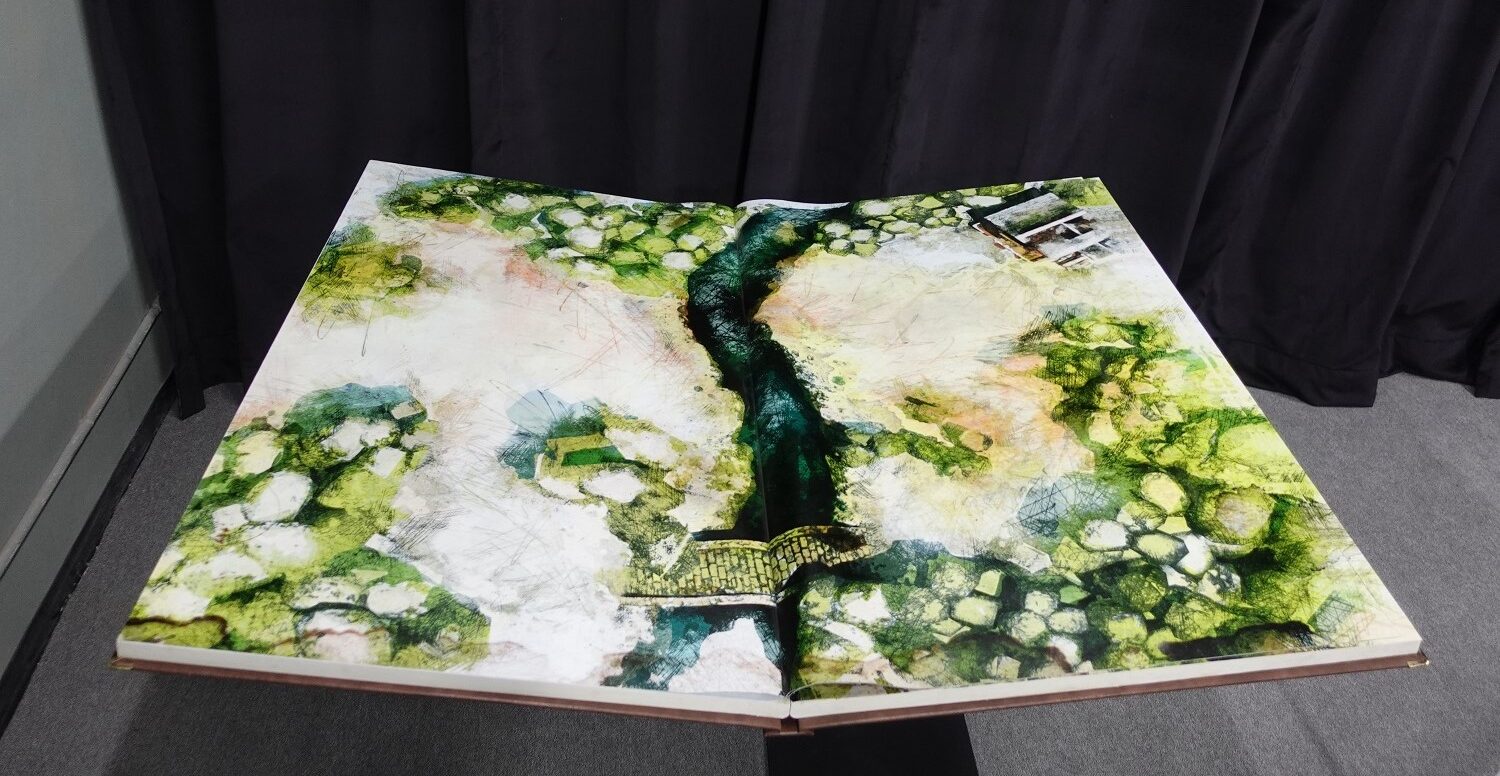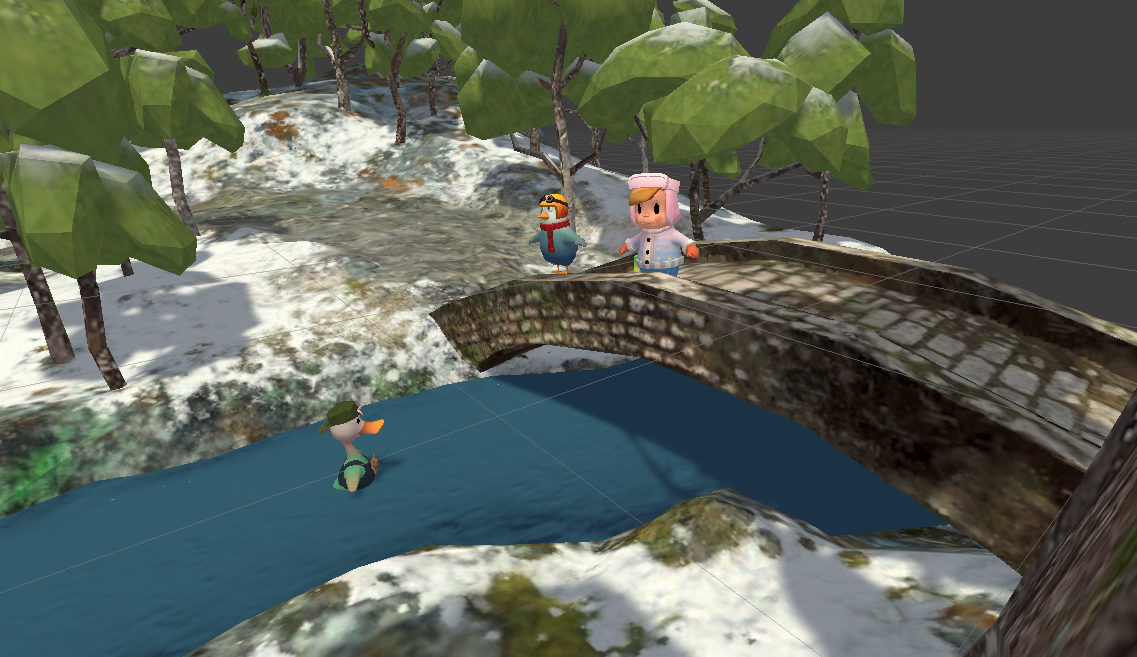《彼得與狼》是一個關於冒險與勇氣的故事,主角小男孩彼得不顧爺爺的勸阻警告,與他的動物夥伴小鳥、鴨子與貓,一同前往森林奮戰大野狼。作品以交響樂形式呈現,一位說書人口述,角色由不同的樂器擔任:「弦樂」飾演彼得,「低音管」飾演爺爺,「長笛」飾演小鳥,「雙簧管」飾演鴨子,「單簧管」飾演貓,「法國號」飾演大野狼,「定音鼓、大鼓」飾演獵人槍聲。交響樂團演奏帶領觀眾進入故事,長笛的清脆聲正如活潑聒噪的小鳥,弦樂以輕快的樂音呈現無懼的彼得踏上冒險旅程,而在法國號低聲沉穩至略為高亢的音色變幻中,彷彿能看見野狼伺機而動的鬼祟姿態。
 巨大有聲書,頁面依照故事劇幕繪製。圖©臺灣當代文化實驗場
巨大有聲書,頁面依照故事劇幕繪製。圖©臺灣當代文化實驗場
作品首演於1936年俄國,作曲家普羅高菲夫(Sergei PROKOFIEV)受莫斯科兒童劇院委託製作,目的是為了讓小朋友初步認識樂器與交響樂。如今《彼得與狼》是交響樂史上最常演出的曲目之一,經常由指揮擔任說書人,台上除了樂團,有時也會結合角色演員演出故事情境;此外也有無數改編版本,如國樂、舞蹈、劇場、繪本、動畫電影等,包含1946年迪士尼的同名短片。本次C-LAB臺灣聲響實驗室全新製作《聲之書:彼得與狼》,則是以「AR有聲書」的形式重現這首經典兒童交響樂童話。
作品鎖定學齡前到國小的小朋友觀眾,以「說故事」為概念,《聲之書:彼得與狼》打造一本長2公尺、寬1公尺的大書,說書人一邊說故事一邊翻頁,化身成小朋友喜歡的說故事大哥哥、大姐姐;而觀眾手持平板對著書頁,能看見躍然紙上的動畫影像,並且同步聆聽樂曲。
奠定這個作品基礎的是交響樂曲,臺灣聲響實驗室邀請國立臺灣交響樂團(簡稱國臺交)擔任音樂演奏,於樂團所在的臺中進行一場規模龐大的錄音工程,現場總共出動近50支麥克風收音,將每種樂器的聲音收錄得非常乾淨。有如此高規格的聲音錄製,才能在後製階段充分發揮聲響實驗室的全景式環繞聲音系統(Ambisonics),這套聲音設計讓作品的聲音樣貌更為細緻,觀眾能感受到聲音在空間中的高低遠近;例如,當小鳥出場時,長笛聲也如鳥在天空盤旋那樣騰空飛旋。音像藝術創作者、亦為本作品導演王新仁表示,在《聲之書:彼得與狼》的演出中,觀眾的聽感就像是處在指揮的位置,被不同樂器包覆,各聲部自四方環繞發聲,而非如處在觀眾席般單向聆聽。
 彼得、小鳥與鴨子分別由弦樂、長笛、雙簧管演出。圖/臺灣聲響實驗室提供
彼得、小鳥與鴨子分別由弦樂、長笛、雙簧管演出。圖/臺灣聲響實驗室提供
《彼得與狼》原始的故事結尾是鴨子被野狼吃掉,而彼得獨自智取野狼,在獵人協助下一起將狼送到動物園,同時展開一場勝利大遊行;這些內容設計皆呼應首演時期蘇聯的政宣觀點,也呈現傳統上非黑即白、好人壞人對立的二元價值觀。《聲之書:彼得與狼》版本將故事結局改寫為大野狼其實是隻沒戴眼鏡、老花眼的狼,他只是想跟大家一起玩,鴨子也沒有被吃掉,最後誤會化解,人類與動物開心玩在一起。AR的動畫與影像製作將故事場景設定為冬雪初融、暖春將至的森林,卡通畫風的彼得、野狼、小鳥等角色隨樂曲登場演出。這本AR有聲書由說書人主導節奏,藉由操作AR介面,說書人能在故事主線以外即興發揮;譬如,當小鳥、鴨子對話時,長笛和雙簧管會同時演奏,這時說書人能重複播放這段樂曲與動畫,引導觀眾辨識這兩種樂器的音色。如此一來,作品能與現場小朋友的反應做互動,為每場演出創造更多意想不到的趣味。
《聲之書:彼得與狼》將在「玩聚場」期間首演,開幕演出由華視主播莊雨潔擔任說書人,她也會為作品錄製一個標準的現場演出版本,其餘神秘說書人正緊密邀約中。《聲之書:彼得與狼》的製作對應著臺灣聲響實驗室的「創作」、「教育」、「研究」三大要務,同時能讓聲音藝術、科技藝術以更親切的姿態融入日常生活。創作團隊希望未來此作品能進入國內外美術館,成為對公眾開放的裝置性藝術教具。